CAMERA unveils “Times Line” — Exposing biased NY Times coverage against Israel
Documenting coverage “obsessed with perceived flaws of the Jewish state and eager to downplay the Palestinian role in perpetuating the ongoing conflict”

The Committee for Accuracy in Middle East Reporting in America (CAMERA) is an international media-monitoring organization that was founded back in 1982 to promote more accurate, balanced, and complete coverage of Israel and the Middle East.
In addition to its many blogs and longform articles which expose an astonishing amount of errors and omissions, CAMERA also produces original research that evaluates how this skewed information on the Israeli-Palestinian conflict is filtered into educational programming in various settings, such as in U.S. college campuses, the K-12 educational system, and in churches.
A recent important new CAMERA study offers a sobering example of how biased teaching materials “promoting a politically-charged agenda” have been used for years by the Newton Public Schools system to teach 9th and 10th graders:
- Case Study: Biased curriculum on Israel and Islam in a Massachusetts school system
- Massachusetts public school assignment simulates Hajj to Mecca
CAMERA is also known for its probing analysis and exposure of media fails from the typical sources: The New York Times, BBC, Washington Post, MSNBC, Associated Press, The Guardian, and Haaretz:
- Top Ten Media Fails of 2015 – Israel Edition
- The most important space in journalism
- A CAMERA in Jerusalem
As we’ve highlighted, over the years CAMERA has demonstrated that the handling of the Arab-Israeli conflict by these media outlets has long been slanted against Israel. The New York Times in particular has been “obsessed with the perceived flaws” of the Jewish state while “eager to downplay” the Palestinian role in perpetuating the conflict.
Our posts already provide some pretty noxious examples:

But now CAMERA is launching a new project to further expose the newspaper’s partisan and unprofessional coverage of Israel. Via an interactive online timeline, it’ll provide detailed evidence of the paper’s biased journalism and will help readers keep track of the paper’s many stumbles. Below I summarize the newly launched project’s main features. An exclusive statement for Legal Insurrection from CAMERA’s senior research analyst Gilead Ini is also included.
A new timeline tracks @nytimes coverage of the Arab-Israeli conflict: https://t.co/vMDHbDdfsl Not a great start to 2018. pic.twitter.com/uSPo0kui1m
— Gilead Ini (@GileadIni) January 31, 2018
CAMERA’s New Project: A 2018 New York Times Line
CAMERA recently launched its “New York Times Line”, an online and interactive timeline that will track the newspaper’s errors on Israel over the course of the year.
The timeline, with entries that include a featured image, short text, and hyperlinks to further CAMERA sources on the topic, will offer readers a “visual way” to hold The New York Times accountable to its promise to be the “arbiter of truth.”
This isn’t the first time that CAMERA has developed a project dedicated to assessing whether the newspaper lives up to its own self-identified standards of fairness and truth. Back in 2012, two of its senior research analysts—Rick Hollander and Gilead Ini—collaborated on a study that evaluated six-months-worth of New York Times coverage of the Israeli-Palestinian conflict between July 1 and December 31, 2011.
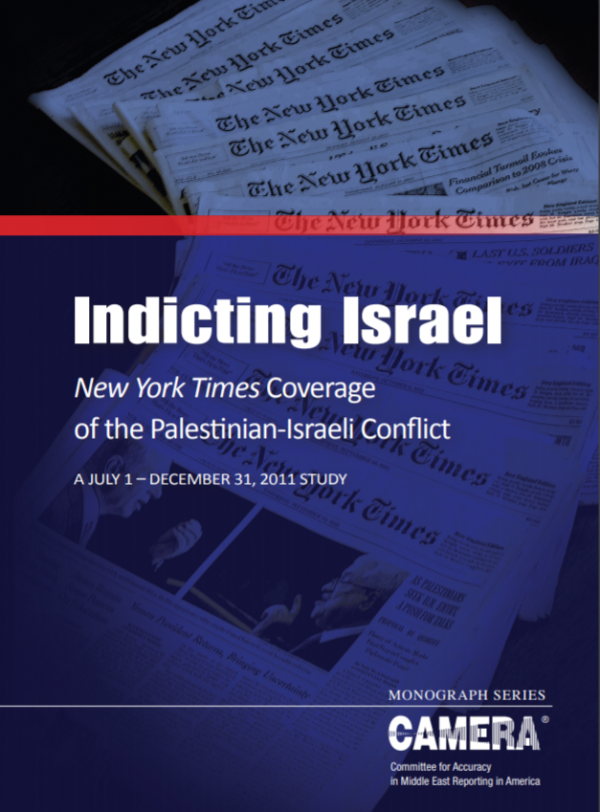
The 100+ page monograph is well-worth reading in terms of its comprehensive analysis of the systematic anti-Israel bias that permeates one of the most influential newspapers in the world. As noted in the study’s Executive Summary:
The dominant finding of the study is a disproportionate, continuous, embedded indictment of Israel that dominates both news and commentary sections. Israeli views are downplayed while Palestinian perspectives, especially criticism of Israel, are amplified and event promoted. The net effect is an overarching message, woven into the fabric of the coverage, of Israeli fault and responsibility for the conflict…”
Six years later, CAMERA’s Gilead Ini is developing the new project to see if the message has remained the same.
Like the 2012 study (and an earlier one released in 2002, which exposed the newspaper’s distorted emphasis on alleged Israeli wrongdoing during the height of the second intifada, when it was combating an unprecedented degree of Palestinian terrorism and violence), the new “Times Line” will document errors and distortions about Israel, double standards, and the paper’s significant omissions of Palestinian incitement and rejectionism—key obstacles in achieving peace.
But unlike the earlier monographs, this new project will be a lot more user-friendly. Instead of a book-length study, the new “Times Line” will offer visually-revealing snapshots of the paper’s coverage (those looking for more detailed analysis can click on the hyperlinks to the longer CAMERA articles on the paper’s reporting on the topic).
As the snapshots accumulate along the timeline, it should be possible to begin to see patterns, in terms of topics that continually repeat and where rigor and fairness are being compromised or if there are certain Times journalists who are prone to repeatedly violating professional norms (for example, norms against editorializing in news reporting).
Some Examples from CAMERA’s New “Times Line”
So far nine entries appear on CAMERA’s new timeline—3 entries from December 2017 and the rest highlighting Times coverage for the months of January and February 2018.
It’s worth having a look at all the entries, and reading through the hyperlinked attachments. Taken together, the entries offer a disturbing picture of how the newspaper is continuing to misinform readers about the realities of the conflict. In correcting the articles’ various missteps and providing readers with the accurate information, the nine entries also offer a pretty decent primer on the conflict and why peace remains so elusive.
Here are a few of the entries that currently appear on CAMERA’s new “Times Line”:
-
Ramallah Remodeled
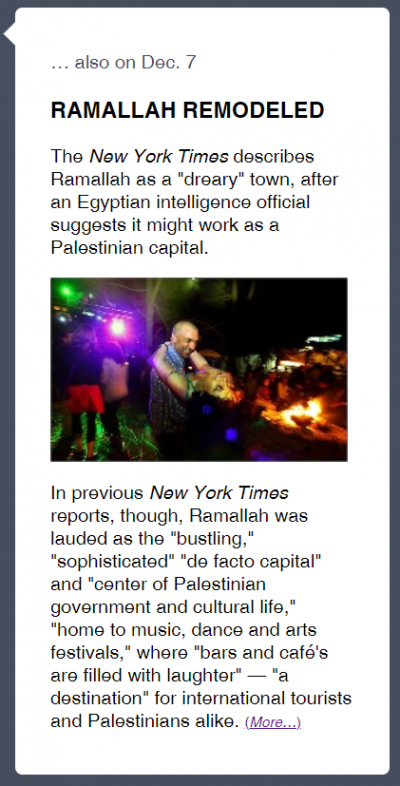
In a front page story devoted to Egypt’s response to the Trump administration formally recognizing Jerusalem as Israel’s capital, New York Times reporter David Kirkpatrick suggests that an Egyptian intelligence officer claimed that for their own capital Palestinians could “content themselves with the dreary West Bank town that currently houses the Palestinian Authority, Ramallah”.
As noted by the CAMERA hyperlinked article to this news story, Kirkpatrick’s description of Ramallah—as dreary, connoting a dismal and gloomy place—is “irreconcilable with [the newspaper’s] earlier descriptions of a Ramallah that’s neither dreary nor a town, but rather an exciting, bustling city.”
The CAMERA article highlights a number of Times stories from 2010 and 2013, in which Ramallah is portrayed as sophisticated and lively, with “laughter-filled cafes”, a vibrant downtown and many “music, dance and arts festivals.”
So either Ramallah is lame. Or Ramallah is epic. Apparently, it’s a “shape-shifting city” because the Times picks and chooses how to describe it based on the message it wants to convey:
It’s a small adjective, but one that underscores a significant point. The newspaper is putting its finger on the scales, coloring a story to make the content of Egypt’s suggestion…seem more objectionable…This example is important, too, because such partisan editorializing in The New York Times, which violates journalistic guidelines, has been all too common.”
-
Soft-pedalling Abbas (Again)

In recent public speeches on December 13, 2017 and January 14, 2018, Palestinian President Mahmoud Abbas said some pretty ugly things.
In reference to Jews, he claimed that there “is no one better at falsifying history or religion than them”, citing God and anti-Jewish verses from the Koran.
He also rejected the Jewish connection to Israel, dubbing it a “colonialist enterprise” that “has nothing to do with Judaism”, and he offered up some wild conspiracy theories to explain the Jewish presence in the country. To top it all off, Abbas provided a modern-day bit of blood libel crackpottery: Israel traffics drugs to the West Bank to debilitate Palestinian children.
This entry in the CAMERA timeline links to an article, “Breaking the Media Silence on Mahmoud Abbas”, which covers the Times decision to ignore this antisemitism by the Palestinian head of state.
Useful in the article is also an assessment of The Atlantic’s coverage of Abbas’s “indiscretions”, which CAMERA’s Gilead Ini praises as “fully informing” readers about Abbas and the “conflict he has failed to resolve”:
Forthright reporting on Abbas shouldn’t be so hard. But too many in the media have struggled with the task…Coverage of Abbas’s role in fomenting hate has been all to scarce. But if a venerated American magazine can do it, there may be hope of the rest.”
-
Siding with the Jews?
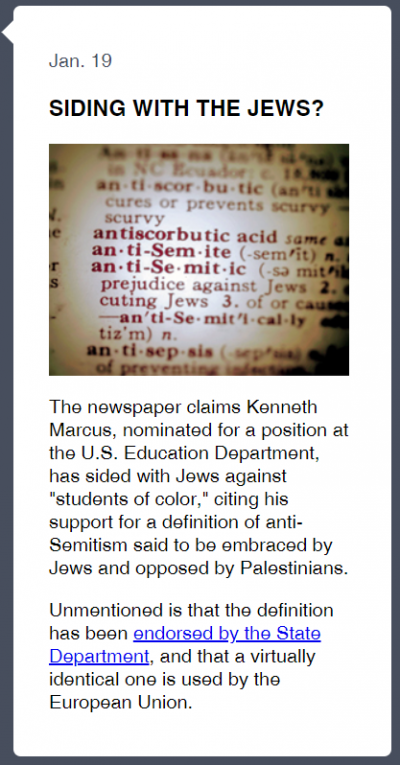
This CAMERA entry criticizes a Times article that covered the controversy over the nomination of Kenneth L. Marcus, Trump’s pick to head the Office for Civil Rights at the U.S. Department of Education (for background, see our most recent post, Kenneth Marcus nomination to head DOE office for civil rights passes Senate HELP Committee).
The entry in the CAMERA timeline specifically takes issue with the way that the Times characterized Marcus’ preferred definition of antisemitism. As we wrote in an earlier post, his understanding of contemporary anti-Jewish hatred isn’t at all controversial, which is probably one of the reasons that virulently anti-Israel activists and organizations began smearing his overall record in order to derail his confirmation.
-
Watering down BDS extremism

This entry in the timeline rightly slams the Times for dramatically mischaracterizing the boycott, divestment, and sanctions (BDS) movement, in a manner that obscures its central goals and that’s rejected even by BDS leaders themselves.
The entry has a hyperlink that directs readers to a CAMERA blog post focuses on why “the New York Times can’t seem to get it right when explaining BDS activism to its readers.”
In its coverage of BDS, the Times bizarrely tends to describe the movement as simply anti-occupation and merely “critical of Israel’s policies towards the West Bank”. It thereby “downplays” its true goals and whitewashes its radicalism.
-
‘Hard-Line’ Jews back Jerusalem capital
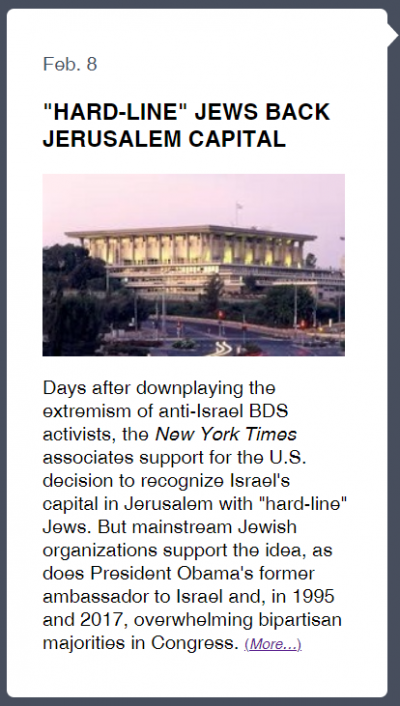
The CAMERA timeline’s last entry so far is devoted to a New York Times news story about Trump’s remarks during the National Prayer Breakfast. White House correspondent Mark Lander writes that Trump “made no mention” of his decision to recognize Jerusalem as the capital of Israel, a move popular with a “segment of hard-line pro-Israel American Jews.”
Here CAMERA rightly criticizes Lander for allowing his opinions and his “feelings” about who would support Trump’s Jerusalem Declaration to color his news story.
The reality is that Trump’s move was supported by many mainstream American Jewish groups. It’s worth noting too that while the Times minimizes BDS extremism and never characterizes BDS activists as radical ‘hard liners’, it sees fit to cast American Jews who support current U.S. policy on Israel in this manner.
CAMERA's New York Times Line keeps track of the paper's stumbles in coverage of Israeli-Palestinian conflict. The latest: a @nytimes news story–not an opinion piece–called Jews who support US recognition of #Jerusalem as Israel's capital "hard-line."https://t.co/rIouZDqrVL pic.twitter.com/EEZJVV5wUn
— CAMERAorg (@CAMERAorg) February 9, 2018
Exclusive Statement from CAMERA’s Gilead Ini
As stated in CAMERA’s February 6 press release, the new “Times Line” project was developed in light of the paper’s recent ad campaign that aims to assure the public that “The Times will hold itself to the highest standards of independence, rigor and fairness.”
Unveiled last year, the campaign has included digital, social and print ads that tackle the complexities of arriving at “the truth” and underscore the importance of properly sourced and researched journalism, delivered “without fear or favor.”
In January, a letter by the newspaper’s new publisher Arthur Greg Sulzberger also promised readers that the Times would be holding itself to the highest standards of journalism.
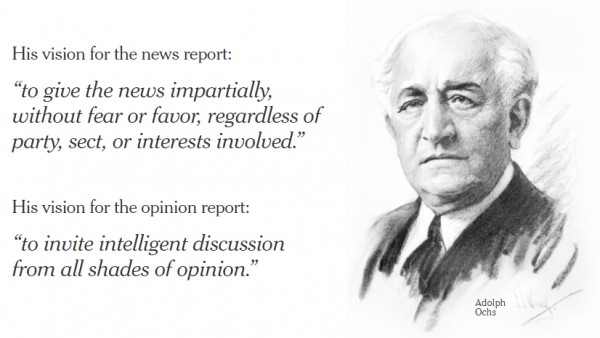
So CAMERA’s new project is perfectly timed to evaluate whether in 2018 the paper will fulfill its promise to tell the truth in its handling of Arab-Israeli conflict.
It’s also a good time to undertake the new CAMERA study because of some staffing changes that have recently taken place. Gilead Ini, who will be leading the new project for CAMERA, mentioned this in a statement for LI:
The new year begins with a relatively new cast of journalists responsible for New York Times reporting on the Arab-Israeli conflict. The most visible of the group, David Halbfinger, began his tenure as Jerusalem bureau chief in the second half of 2017. So did Middle East editor Herbert Buchsbaum and standards editor Rogene Jacquette. So it’s important to keep a close eye on what effect the updated roster will have on the newspaper’s often questionable, always controversial coverage of the Middle East. Our ‘Times Line’ puts that information at a glance, concisely on one page — and it shows that the newspaper is off to a bad start to 2018.”
Conclusion
The New York Times—both in its print and online versions—are read and relied upon by millions of opinion-leaders in America and across the planet. Dubbed the ‘newspaper of record’, the Times sets the topics and the tone for many other media outlets on the left, especially in terms of what is deemed newsworthy and how stories are framed.
So the appalling pattern of bias in its presentation of the complex Israeli-Palestinian conflict really matters. It at least partly explains why so many people on the left are so hostile to Israel.
Bottom line: The New York Times is right: the truth is indeed hard. At least when it comes to Israel and the Middle East, the newspaper will have to try harder to convince readers that they can rely on its pages to convey it fully and fairly.
[Featured Image: CAMERA billboard across from NY Times headquarters, full image here.]
Miriam F. Elman is an Associate Professor of Political Science and the Inaugural Robert D. McClure Professor of Teaching Excellence at the Maxwell School of Citizenship & Public Affairs, Syracuse University. She is the editor of five books and the author of over 65 journal articles, book chapters, and government reports on topics related to international and national security, religion and politics, and the Israeli-Palestinian conflict. She also frequently speaks and writes on the Boycott, Divestment, and Sanctions (BDS) anti-Israel movement. Follow her on Facebook and Twitter @MiriamElman
 DONATE
DONATE
Donations tax deductible
to the full extent allowed by law.








Comments
This has been common knowledge among conservatives and Christians for years. I doubt it will change.
I’m trying to put on my shocked face, but nothing about the anti-American, anti-Israel propaganda machine shocks me anymore.
They tried the “separation” angle, but that was a factional failure.
The NY Times has been a propaganda rag since the late thirties, when they spread propaganda for the Soviets.
They’ve been fully exposed as leftist parasites. If the NY Times lauds someone or defends them, you can be sure they’re corrupt leftist scum.
Guilt by association is a bitch:
Walter Duranty served as the Moscow Bureau Chief of The New York Times for 14 years following the Bolshevik victory in the Russian Civil War.
Duranty received a Pulitzer Prize for a series of fake reports in the NY Times about the Soviet Union, denying widespread famine (1932–1933) in the USSR, most particularly the mass starvation in Ukraine (in which Stalin killed 6 million people). Years later, there were calls to revoke his Pulitzer – but not by the NY Times.
https://en.wikipedia.org/wiki/Walter_Duranty
If it were only the anti-Semite part of the NYT that was vile it would be nasty but would fit in with the many leftist organizations that exist. But this is only one evil measure of the paper. It has so many unAmerican agendas and viewpoints that are responsible for many of the problems the msm are facing today. Between the WaPo and the NYT, they literally created the term “Fake news” not by their use of the phrase but because they created so much fake news. Never has so much egregious behavior been allowed to exist for so long as the one-sided and divisive “News” that they have gotten away with.
I wonder how many Jews are employed by the NYT. It seems the average red state deplorable is far more supportive of Israel than many highly educated American jews.
Just more pain for those select few who have suffered the most ever in the totality of human history. And all it can do is get worse and worse and worse if we dare ever to forget in the slightest way.
Good poster, but, the word “great” should be in quotation marks, because the New York Times’ “greatness” is an entirely subjective and alleged characterization, and, isn’t at all universally recognized, except solely in the minds of the lemming Leftists who dutifully swallow its propaganda narratives.